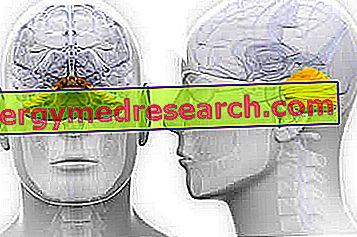Generality
The cerebellum is an important region of the brain, so it is an element of the so-called central nervous system.
Egg-shaped and weighing about 130-140 grams, the cerebellum resides in the posterior part of the brain, protected by a structure known as posterior cranial fossa.

Like any organ of the central nervous system, the cerebellum has a portion of gray substance (which forms the so-called cerebellar cortex) and a portion of white substance (in which the so-called cerebellar nuclei take place).
The cerebellum plays a key role in learning and motor control, in coordination, in the sense of balance and in some cognitive functions related to language and attention.
Short reference to the central nervous system
The central nervous system ( CNS ) is - together with the peripheral nervous system ( PNS ) - one of the two main components of the human nervous system .
The central nervous system is made up of two structures: the brain and the spinal cord .
Acting as a processing and control center, the central nervous system analyzes the information coming from the external and internal environment of the organism and responds accordingly, appropriately and according to what the aforementioned information requires.
What is the cerebellum?
The cerebellum is an important portion of the central nervous system; to be precise, it is a region of the brain.
It has several tasks, all of which are quite relevant; mainly, it is involved in learning and motor control.
The cerebellum is a very complex element of the nervous system. The intent of this article is to explain it in a simplified and understandable way.
brain
It is a highly complex structure, which in adult humans can weigh up to 1.4 kilograms (ie about 2% of total body weight).
According to neurologists, it would contain more than 100 billion neurons (NB: one billion corresponds to 1012); therefore, the connections it can establish are many and unimaginable.
In the encephalon, 4 regions are recognizable: the telencephalon (or brain proper ), the diencephalon, the brainstem and the aforementioned cerebellum . Each of these regions has a specific anatomy, with compartments used for very specific functions.
Twelve pairs of cranial nerves depart from the brain, identified with Roman numerals I to XII.
Except for the I and II pair of nerves, which originate respectively in the telencephalon and in the diencephalic, the remaining twelve pairs are born in the brainstem.
SYNONYMS AND DERIVATIVE TERMS
The cerebellum is also known as cerebello . It is a term used very rarely in anatomy, but from which it derives a very common adjective: cerebellar .
| REGION | FUNCTION |
Telencephalon or brain proper | |
Cerebral cortex | Perception; movement and coordination of voluntary musculature |
Basal ganglia | Movement |
Libyan system | Emotion; memory; learning |
Diencephalus | |
Talamo | Transit station for motor and sensory information |
Hypothalamus and pituitary gland | Instinctive behaviors; secretion of various hormones |
Epitalamo and epiphysis | Melatonin secretion |
Cerebellum | Coordination of the movement |
Encefalic trunk | |
Mid-brain | Eye movement; coordination of auditory and visual reflexes |
Bridge (or Varolio bridge) | Transition station between brain and cerebellum; breath control |
Elongated marrow | Control of visceral functions |
Lattice formation | State of consciousness; sleep-wake cycles; muscle tone; pain modulation |
Anatomy
The cerebellum has an ovoid shape, weighs approximately 130-140 grams (in an adult subject) and resides in the posterior part of the brain, protected by the so-called posterior cranial fossa
Similar to the brain proper, the cerebellum consists of two lateral expansions, with respect to a midline. The two lateral expansions take the name of cerebellar hemispheres, while the median line is called vermis (it derives from the Latin and means worm ).
Like all the structures that make up the central nervous system, the cerebellum has the so-called gray substance and the so-called white substance . The gray substance resides on the surface of the cerebellum and forms that folded coating known as the cerebellar cortex . The white substance, instead, takes place in the deeper layers of the cerebellum and represents the site of the so-called cerebellar nuclei .
As far as its histology is concerned, the cerebellum includes numerous types of nerve cells (or neurons ), each with its own precise role. Among the various types of nerve cells that make up the cerebellum, they certainly deserve a mention: Purkinje cells, granule cells, Golgi cells, basket cells and stellate cells .
Curiosity
The cerebellum represents 10% of the total brain volume; nevertheless, however, it contains more than 50% of the total neurons present in the brain complex.

SUBDIVISIONS
To facilitate understanding of the cerebellum and its anatomy, experts have established that there are three different ways of describing the nerve organ in question.
A first way of describing the cerebellum divides the latter into anatomical lobes ; a second way divides the cerebellum into zones ; finally, a third way divides the cerebellum into functional areas .
- Division of the cerebellum into anatomical lobes .
It recognizes on the cerebellum the existence of three lobes: the anterior lobe, the posterior lobe and the flocculonodular lobe .
Moreover, it also gives its name to two fissures: the primary fissure and the posterolateral fissure .
The primary fissure is the fissure that separates the anterior lobe from the posterior lobe; the posterolateral fissure, on the other hand, is the fissure that separates the posterior lobe from the flocculonodular lobe.

- Division of the cerebellum into zones .
It recognizes on the cerebellum the existence of three zones: the area of the worm, the intermediate zone and the area of the lateral hemispheres .
The area of the worm corresponds to the median line formed by the vermis ; the intermediate area is the area that runs alongside, on the right and on the left, the vermis ; finally, the area of the lateral hemispheres is the area that flanks, on the right and on the left, the intermediate zone.

- Division of the cerebellum into functional areas .
It recognizes on the cerebellum the existence of three functional areas: the cerebro-cerebello (or cerebral cerebello ), the spino-cerebello and the vestibule-cerebello .
The cerebro-cerebellum coincides with the area of the lateral hemispheres and represents the functional area of greatest extension.
The spino-cerebello is the functional area between the worm area and the intermediate zone.
Finally, the vestibulum cerebello is equivalent to the flocculonodular lobe.
REAR CRANIAN FOSSA: WHAT IT IS
The posterior cranial fossa is a broad depression of the inferior-posterior portion of the skull .
The squamous and mastoid parts of the temporal bone of the skull and a good part of the occipital bone of the skull participate in the formation of the posterior cranial fossa.
GRAY SUBSTANCE: CEREBELLAR BARK
The cerebellar cortex can be divided into three overlapping layers.
To compose the deepest layer - that is the innermost one - are the granule cells.
The Purkinje cells form the intermediate layer.
Finally, to constitute the outermost layer are, predominantly, the cell axons of the granules and the dendrites of Purkinje cells (NB: axon and dendrites are two fundamental parts of neurons).
- Granule cells: cells of very small size, they represent the most common neurons in the cerebellum and about half of the neurons of the whole brain.
- Purkinje cells: they are among the largest neurons in the brain. They contribute fundamentally to the motor control by the cerebellum.
Although in much lower quantities than the granule cells and Purkinje cells, the cerebellar cortex contains: Golgi cells, basket cells and stellate cells.
WHITE SUBSTANCE: CEREBELLAR CORE
The cerebellar nuclei - that is, the nuclei of the cerebellum - are groups of neurons with specific functions.
In all, they are four and are called: dentate nucleus, emboliform nucleus, globular nucleus and roof nucleus (or fastigium nucleus).
- Tooth core . It belongs functionally to the cerebro-cerebello.
- Embolic core . It belongs functionally to the spino-cerebello.
- Globular nucleus . It belongs functionally to the spino-cerebello.
- Core of the roof (or core of the fastigium ). It belongs functionally to the vestibule-cerebello.
BORDERS AND RELATIONS
The cerebellum borders:
- Posteriorly, with the occipital bone of the skull .
- Anteriorly, with the fourth ventricle, the Varolio bridge and the medulla oblongata (NB: the Varolio bridge and the elongated medulla are two portions of the brainstem, another region of the four forming the encephalon).
- Above, with the so-called tentorium of the cerebellum . The cerebellum of the cerebellum is the portion of dura mater (meningis of the central nervous system), which separates the cerebellum from the occipital lobes of the brain proper.
As far as its relations are concerned, the cerebellum communicates with the brainstem by means of the so-called cerebellar peduncles . In all 6 and arranged in pairs (therefore 3 pairs), the cerebellar peduncles are bundles of nerve fibers both afferent (ie that go from the periphery to the CNS) and efferent (ie ranging from the CNS to the periphery).
Named according to their position with respect to vermis, the three pairs of cerebellar peduncles are:
- The pair of lower cerebellar peduncles . The lower cerebellar peduncles contain predominantly afferent fibers, coming from the medulla oblongata, and a small amount of efferent fibers.
- The pair of medium cerebellar peduncles . The medium cerebellar peduncles contain afferent fibers, coming from the Varolio bridge.
- The pair of upper cerebellar peduncles . The upper cerebellar peduncles contain mainly efferent fibers, which, from the cerebellar nuclei, reach the cerebral cortex, and a small amount of afferent fibers.
ARTERIAL VASCULARIZATION
The influx of oxygenated blood to the cerebellum depends on three arteries ; present in pairs, these three arteries are: the superior cerebellar artery, the anterior inferior cerebellar artery and the posterior inferior cerebellar artery .
The superior cerebellar artery and the anterior cerebellar artery are two branches of the so-called basilar artery . The basilar artery is an important arterial vessel, which supplies different brain structures with oxygenated blood.
The posterior cerebellar artery, on the other hand, is a branch of the so-called vertebral artery . The vertebral artery is the main arterial blood vessel in the neck; originates from the subclavian artery and gives rise to the aforementioned basilar artery.
VENOUS VASCULARIZATION
The drainage of venous blood (ie blood poor in oxygen) from the cerebellum depends on the superior cerebellar vein and the inferior cerebellar vein . In fact, both of these veins drain the blood out of the cerebellum into three venous sinuses of the dura mater: the so-called upper petrous sinus, the so-called transverse sine and the so-called rectum sinus .
Development
During embryonic development, the anterior portion of the neural tube gives rise to three vesicles (or parts), from which the brain and the structures associated with the brain derive.
These three vesicles are called forebrain, midbrain and rhombencephalon .
The cerebellum derives from the rhombencefalo or, to be more precise, from one of the two subdivisions of the rhombencefalo, the so-called metencephalon (NB: the other subdivision is the myelencephalon).
Functions
The cerebellum is best known for its motor functions ; however, it also plays an important role in some cognitive functions.
As far as motor functions are concerned, the cerebellum is implicated in the processes of:
- Coordination of voluntary muscles . Most of the movements that human beings perform daily involve, harmoniously, a set of muscles. For example, the gesture of touching the tip of the nose with a finger of the hand involves the simultaneous and coordinated intervention of the shoulder, elbow and wrist muscles.
The cerebellum controls the harmony of movements that involve a complex of muscles and causes the aforementioned movements to unfold fluently, without interruption.
- Adjustment of balance and posture . The cerebellum presides over postural adjustments in order to maintain balance.
- Motor learning . The cerebellum is the organ of the nervous system that allows the human being to learn the execution of gestures, such as hitting a baseball, shooting a basket, etc.
The gestures in question result from precise movements of the muscles of the body, movements that are generally learned with practice, after several attempts and various errors.
As for cognitive functions, the cerebellum controls:
- Attention skills e
- The language .
CHECK THE EMOTIONS?
According to some neurologists, the cerebellum would be implicated in some emotional functions, such as the response to fear or the response to pleasure.
CEREBRO-CEREBELLO: FUNCTIONS
The cerebro-cerebello is implicated in the mechanisms of motor learning and coordination of voluntary muscles.
SPINO-CEREBELLO: FUNCTIONS
The spino-cerebello regulates the movements of the body and helps the cerebro-cerebellum in motor learning.
VESTIBOLO-CEREBELLO: FUNCTIONS
The vestibule-cerebello presides over the control of balance and posture.
diseases
Among the most well-known pathologies affecting the cerebellum are: Arnold-Chiari syndrome, cerebellar ataxia, strokes and cerebellar tumors (NB: tumors understood as benign and malignant neoplasms).
Types of cerebellum cancer:- Astrocytoma
- Medulloblastoma
- Glioblastoma
- Cerebral cavernoma
ARNOLD-CHIARI SYNDROME
Arnold-Chiari syndrome, or Chiari malformation, is a set of symptoms and signs that arises due to a malformation of the posterior occipital fossa, or the site of the cerebellum.
Due to this malformation, the hemispheres of the cerebellum tend to move downwards, precisely in the direction of the occipital hole and the underlying spinal canal.
Experts often define Arnold-Chiari syndrome as cerebellar hernia .
CEREBELLAR ATAXIA
The term cerebellar ataxia indicates a group of genetic diseases characterized by a lesion of the cerebellum or of the nerve pathways that it controls. It is a neurodegenerative pathology, which involves the onset of coordination difficulties in the upper and lower limbs, optic atrophy, difficulty in articulating the word, etc.
CONSEQUENCES OF A DAMAGE TO CERVELLETTO
The damage to the cerebellum compromises the functionality of this important brain structure.
The consequences of damage to the cerebellum vary in relation to the damaged cerebellar area.
The list of possible symptoms and signs of cerebellum damage includes:
- Ataxia : is the lack of coordination of voluntary muscle movements.
In performing a gesture that involves more muscles, an individual with a cerebellum damage performs broken movements and totally without harmony. For example, if he touched the tip of his nose with a finger, he would first move his shoulder, then his elbow and then his wrist;
- Dysarthria : difficulty in articulating words. It is a disorder of spoken language;
- Dismetry : indicates the altered execution of voluntary movements;
- Muscle hypotonia : is the loss of muscle tone. Cerebellum damage causes generalized muscle hypotonia, which means that it affects all the muscles of the human body;
- Inability to learn new movements with the body : several studies, on humans and animals, have shown that cerebellum damage causes a motor learning deficit.
- Nystagmus : is the rapid and repeated movement of the eyeball, due to muscle spasms;
- Dysdiadocokinesia (or adiadococinesia ) : it is the inability or difficulty to perform, with a rapid rhythm, alternating movements, in opposite directions. For example, difficulties arise in the occasion of pronation and supination movements of the hand or in the case of flexion and extension movements of the forearm, with respect to the arm.
- Loss of balance : this is the typical consequence of damage to the functional area of the cerebellum known as vestibulum cerebello.



